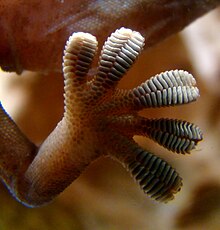Seta



Pada biologi, setae /ˈsiːtiː/ (tunggal: seta /ˈsiːtə/; dari kata bahasa Latin untuk "rambut kejur") merujuk kepada berbagai jenis struktur mirip rambut kejur atau rambut pada organisme.
Fungsi, bentuk dan detail dari seta sangat beragam. Pada hewan, seta dapat berfungsi sebagai mekanoreseptor dan kemoreseptor seperti pada kepiting[1] dan lalat, menangkap fitoplankton seperti pada kril, hingga membantu untuk menempel pada permukaan vertikal melalui proyeksi skala nano yang disebut dengan spatulae, yang dapat ditemukan pada cecak.[2] Pada fungi, seta merujuk kepada struktur sisditium mirip jarum pada jamur corticioid dan jamur poroid pada famili Hymenochaetaceae.[3] Sementara itu, pada tumbuhan seta merujuk kepada tangkai yang menyokong sporangium pada lumut.
Referensi[sunting | sunting sumber]
- ^ Garm, A (2004). "Revising the definition of the crustacean seta and setal classification systems based on examinations of the mouthpart setae of seven species of decapods" (PDF). Zoological Journal of the Linnean Society. 142 (2): 233–252. doi:10.1111/j.1096-3642.2004.00132.x
 .
.
- ^ Santos, Daniel; Matthew Spenko; Aaron Parness; Kim Sangbae; Mark Cutkosky (2007). "Directional adhesion for climbing: theoretical and practical considerations". Journal of Adhesion Science and Technology. 21 (12–13): 1317–1341. doi:10.1163/156856107782328399. ISSN 0169-4243.
Gecko "feet and toes are a hierarchical system of complex structures consisting of lamellae, setae, and spatulae. The distinguishing characteristics of the gecko adhesion system have been described [as] (1) anisotropic attachment, (2) high pulloff force to preload ratio, (3) low detachment force, (4) material independence, (5) self-cleaning, (6) anti-self sticking and (7) non-sticky default state. ... The gecko’s adhesive structures are made from ß-keratin (modulus of elasticity [approx.] 2 GPa). Such a stiff material is not inherently sticky; however, because of the gecko adhesive’s hierarchical nature and extremely small distal features (spatulae are [approx.] 200 nm in size), the gecko’s foot is able to intimately conform to the surface and generate significant attraction using van der Waals forces.
- ^ Kirk PM, Cannon PF, Minter DW, Stalpers JA (2008). Dictionary of the Fungi
 (edisi ke-10th). Wallingford: CABI. hlm. 116. ISBN 978-0-85199-826-8.
(edisi ke-10th). Wallingford: CABI. hlm. 116. ISBN 978-0-85199-826-8.
